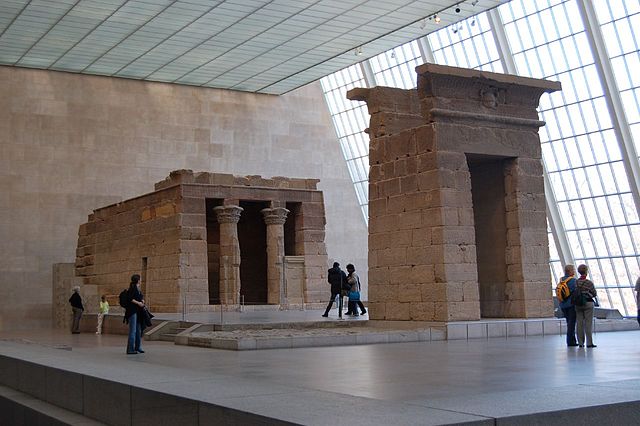Your governor Gaius Petronius to Imperator Caesar Divi Filius Augustus, very many greetings. I write to you to inform you about the Temple of Dendur which you so commissioned. Below is written a description of the temple itself as well as explanations of Egyptian motifs depicted throughout the temple.
What Is the Temple of Dendur?
The Temple of Dendur is THE place for local Egyptians to perform rituals to the gods, which will ensure their community a future of great prosperity. You will be pleased to see that this is no ordinary temple – from the capitals of the columns decorated with papyrus and lily plants – to the vibrant colors throughout. The solid construction is made from Nubian sandstone and consists of the temple itself and a gate, which are separated by a welcoming courtyard space. You will find great attention to detail in the temple’s three main parts; the pronaos, the antechamber, and the sanctuary.
Location, location, location. The temple is located in Upper Egypt close to Nubia on the west bank of the Nile. Brilliant natural light shines on the outer walls of the temple, outlining the carved scenes to make them even more vivid. Inside the first room, the indirect light works hand in hand with the raised relief style, again, making the figures of you, Augustus, most prominent.
Boasting over 18,000 cubic feet of space, this temple is an architectural marvel dedicated to the gods. Its approximate measurements are as follows: 41 feet long, 21 feet wide, 21 feet high, separate gate/entrance located around 30 feet away, which in entirety is 661 blocks weighing a total of 640 tons. I have attached a drawing of the temple below.

Who Is the Temple of Dendur Dedicated To?
Isis is the main goddess to which the temple is dedicated, which will please the Nubians as she is greatly revered by them. She can be most directly compared in Roman religion with the goddess Juno. Isis is associated with the protection of women and is seen as a queen of the Egyptian gods.
Pedesi and Pihor are also depicted in the temple. They are not gods, yet are also revered greatly by the local Nubian population, both because they are sons of local royalty and because they died by drowning in the Nile. In Egyptian culture, this is seen as a symbol of honor from the gods. They believe the god of the Nile, Hapy, specifically chose those two people for that honor.
The other major gods depicted are Horus, Osiris, and Hapy. Horus, the god of war and the sky, can be equated to the Roman Mars. Osiris is the god of the dead and afterlife, ruler of the underworld. He is married to Isis and thus correlates with multiple Roman gods: Jupiter and Pluto. Hapy is the river god of the Nile, similar to the Roman river gods such as Tiberinus of the river Tiber.
Are You, Augustus, Depicted in the Temple of Dendur?
You, O Imperator, are of course represented alongside the gods in the Egyptian temple. I have attached two examples of the many drawings in which you are featured. In both pictures, you are making a libation and burning incense for the gods you are with; the first one honoring Pedesi and Pihor, and the second honoring Isis and Osiris. In return, the gods are shown granting you with life, depicted by the ankh. You have been represented as a traditional pharaoh in terms of dress and are also named as such.


Why Should You, Augustus, Care?
This is an important way for you to gain respect from the Nubians and the Egyptians as a whole. By building these temples for the people and also including yourself in them, they work as a way to solidify your power and claim to Egypt while also gaining the respect of the local people.
Now that you have received and read this information, you, O Imperator, will win great favor with the local population in Egypt. I pray that you will be revered and worshipped as the Egyptian gods are by the Nubians and across Egypt. Please, write to me, lest I am able to further fulfill any of your requests. Your loyal governor, Gaius Petronius.
About me: Raina Land is a sophomore at Colgate University with intended majors in Russian and Eurasian Studies and Classics. She is always interested in learning about the stories behind art pieces.
